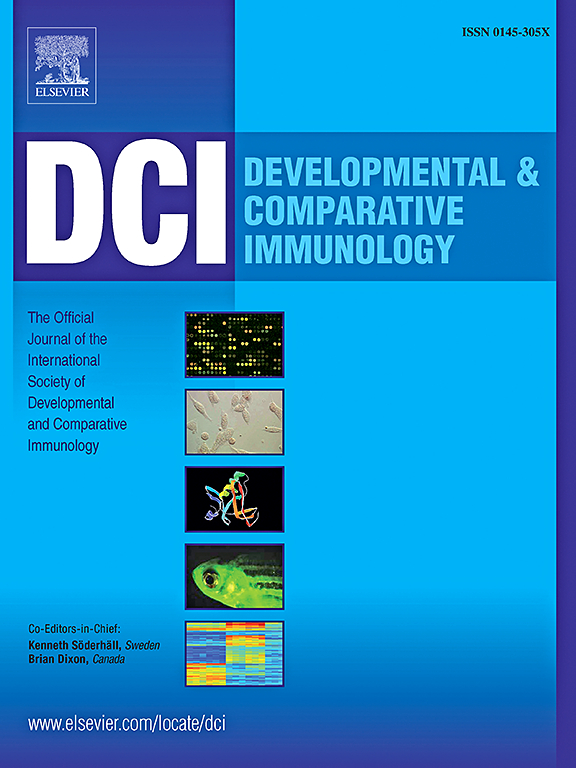CqProfilin enhances WSSV infection by promoting viral intracellular transport through binding to both viral nucleocapsid and actin cytoskeleton
IF 2.4
3区 农林科学
Q1 FISHERIES
引用次数: 0
Abstract
White spot syndrome virus (WSSV) is a large nuclear-replicating DNA virus of crustaceans such as shrimp and crayfish; however, the molecular mechanisms facilitating its transport from the invasion site to the cell nucleus have not yet been well elucidated. In this study, a CqProfilin (CqPFN) with a conserved PROF domain was identified from the red claw crayfish Cherax quadricarinatus. CqPFN was ubiquitously expressed in all examined tissues and hemocyte, with the highest levels in the hemocyte, followed by hematopoietic tissue (Hpt) from which the hemocyte were derived in crayfish. The transcript of WSSV genes such as IE1 and VP28 was obviously decreased both in vivo in hemocyte and Hpt, as well as in vitro in cultured Hpt cells, after CqPFN gene silencing; in contrast, the expression of viral genes was significantly increased by the introduction of a recombinant CqPFN protein in Hpt cells in vitro. Moreover, CqPFN was clearly colocalized with the main viral nucleocapsid protein VP664 and F-actin cytoskeleton, respectively, during the early stage of WSSV infection in Hpt cells. In addition, CqPFN was confirmed to interact with a truncated VP6642,405-2,535 and another viral nucleocapsid protein VP15 of WSSV and Cqβ-Actin from Hpt by co-immunoprecipitation assays. Further studies found that VP664 also colocalized with F-actin in the Hpt cell cytoplasm after WSSV infection, suggesting that the actin cytoskeleton was involved in the intracellular transport of incoming viral nucleocapsid. Taken together, CqPFN might combine with the actin cytoskeleton to promote WSSV infection through binding with viral nucleocapsid proteins VP664 and VP15, promoting intracellular transport of viral incoming nucleocapsid for further releasing genome into the nucleus for transcription. Collectively, these results provided an understanding of the WSSV pathogenesis, which will contribute to the development of an antiviral strategy against WSSV disease.
CqProfilin 通过与病毒核壳和肌动蛋白细胞骨架结合,促进病毒在细胞内的运输,从而增强 WSSV 感染。
白斑综合征病毒(WSSV)是一种甲壳类动物(如虾和螯虾)的大型核复制 DNA 病毒;然而,促进其从入侵部位向细胞核运输的分子机制尚未得到很好的阐明。本研究从红爪螯虾 Cherax quadricarinatus 中鉴定出一种具有保守 PROF 结构域的 CqProfilin(CqPFN)。CqPFN在所有受检组织和血细胞中均有普遍表达,其中血细胞中的表达量最高,其次是造血组织(Hpt),而螯虾的血细胞正是来自造血组织。CqPFN 基因沉默后,WSSV 基因如 IE1 和 VP28 的转录本在体内血细胞和 Hpt 以及体外培养的 Hpt 细胞中都明显减少;相反,在体外 Hpt 细胞中引入重组 CqPFN 蛋白后,病毒基因的表达明显增加。此外,在Hpt细胞感染WSSV的早期阶段,CqPFN分别与主要病毒核壳蛋白VP664和F-肌动蛋白细胞骨架明显共定位。此外,通过共沉淀免疫测定,证实了 CqPFN 与截短的 VP6642,405-2,535 和 WSSV 的另一种病毒核壳蛋白 VP15 以及 Hpt 的 Cqβ-Actin 相互作用。进一步的研究发现,在感染 WSSV 后,VP664 还与 Hpt 细胞胞质中的 F-肌动蛋白共定位,这表明肌动蛋白细胞骨架参与了传入病毒核苷酸的胞内运输。综上所述,CqPFN可能与肌动蛋白细胞骨架结合,通过与病毒核苷酸蛋白VP664和VP15结合促进WSSV感染,从而促进病毒核苷酸的胞内转运,进一步将基因组释放到细胞核内进行转录。总之,这些研究结果有助于人们了解 WSSV 的致病机理,从而有助于开发针对 WSSV 疾病的抗病毒策略。
本文章由计算机程序翻译,如有差异,请以英文原文为准。
求助全文
约1分钟内获得全文
求助全文
来源期刊
CiteScore
6.20
自引率
6.90%
发文量
206
审稿时长
49 days
期刊介绍:
Developmental and Comparative Immunology (DCI) is an international journal that publishes articles describing original research in all areas of immunology, including comparative aspects of immunity and the evolution and development of the immune system. Manuscripts describing studies of immune systems in both vertebrates and invertebrates are welcome. All levels of immunological investigations are appropriate: organismal, cellular, biochemical and molecular genetics, extending to such fields as aging of the immune system, interaction between the immune and neuroendocrine system and intestinal immunity.

 求助内容:
求助内容: 应助结果提醒方式:
应助结果提醒方式:


